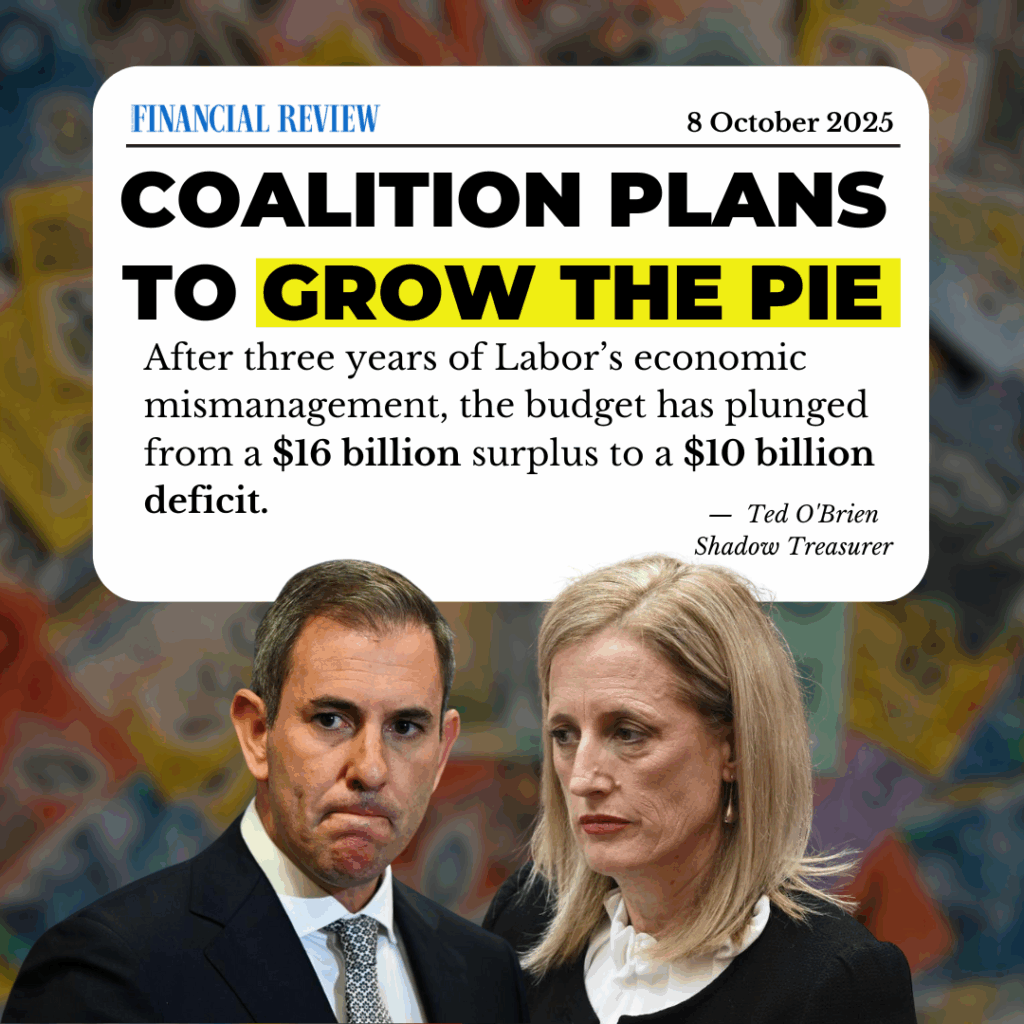As published in the AFR on 8 October 2025
Last week, three years of Labor economic mismanagement came home to roost.
On Monday, the treasurer released the Final Budget Outcome for 2024-25, boasting he had “engineered” the largest budget improvement in history.
But, in fact, he was announcing the budget had plunged into deficit, to the tune of $10 billion after the prior year’s $16 billion surplus
Only Jim Chalmers – literally a doctor of spin, not economics – could dress up a $26-billion deterioration in the bottom line as fiscal responsibility.
And in case you thought this deterioration was due to factors outside the treasurer’s control, think again. As the Coalition revealed that same day, if the government had simply made room for its new spending commitments with savings elsewhere, that $10 billion deficit would instead have been a $12 billion surplus.
That is, if you simply take the budget forecast for 2024-25 at the time of the 2022 election and add the forecast errors since that time, the budget would be in surplus.
You read that right: Jim Chalmers is claiming credit for forecast errors. In truth, he turned a Coalition surplus into a Labor deficit, and his plan is for 10 more of them.
This fiscal irresponsibility has real consequences for real people.
The national debt would be $100 billion lower today had the treasurer run the same kind of disciplined budget process that everyday Australian households have been running throughout this cost-of-living crisis.
Australian families have been living within their means to make ends meet. Meanwhile, Chalmers has racked up debt of $4000 for every man, woman and child in Australia.
And mark my words: he will be coming after them soon enough to pay for it.
The national debt will breach $1 trillion this year and $1.2 trillion by the next election. That enormous debt pile comes with a $50,000 interest bill every single minute. Two minutes, that’s a nurse we can’t afford. Another four minutes, it’s a doctor.
And if this government’s fiscal recklessness eventually loses Australia its AAA credit rating, those interest costs will go even higher.
The pandemic years may have lulled us into a false sense of security about our debt position, but we must never forget it has real consequences.
Labor’s high debt is leaving Australia exposed in the event of a future crisis.
We should ask ourselves: will we be as well placed to handle economic shocks in the future as we were in the past?
The Coalition balanced the budget after the Keating years, so we were in a strong position to weather the global financial crisis. The Coalition balanced the budget after the Rudd-Gillard-Rudd years, so we were in a strong position to weather the pandemic.
If Chalmers had banked the record budget windfall he received over the past four years, our debt burden would have been cut by a quarter.
Replenishing our fiscal buffers so we can respond effectively to the next crisis would have been particularly prudent given the vast global uncertainties facing us.
Instead, Chalmers went on a spending spree. Spending is growing four times faster than the economy and this year will reach the highest level outside of recession since 1986.
Then, on Tuesday, we saw another consequence of this.
While interest rates are still coming down across the rest of the world, having already fallen farther and faster than here in Australia, our rates are on hold.
The RBA is worried about persistent inflation after the prior week’s hot CPI print showed inflation at its highest level in a year.
Despite Chalmers’ repeated claims to the contrary, when government spending grows four times faster than the economy, this keeps inflation high, working against the RBA.
Chalmers’ foot is on the accelerator while Bullock’s is on the brakes.
The treasurer is keen to point to stronger private demand in the most recent national accounts, but that’s a rosy view of a single set of figures.
In truth, this supposed shift from the public to the private sector is explained by strong consumer spending alongside a one-off pause in public works. Meanwhile, business investment is flat-lining.
The truth is in the budget in black and white: government continues to expand.
The markets don’t expect another cut until February and they fear it may be “one and done”. That’s all the relief Labor’s spending spree has left room for.
Enough is enough.
The Coalition will offer a different approach, hinging on two actions: stop the spending spree, and start growing the pie.
It’s early days, but we are already working on a plan that offers lower spending, lower taxes and lower debt than Labor, with faster growth to support higher living standards.
Ours will be a private sector-led plan that restores the Australian people, not government, to the centre of society.
